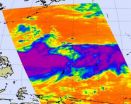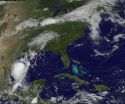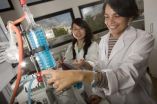(Press-News.org) CINCINNATI—New University of Cincinnati (UC) research on HIV testing at local emergency departments shows that hospitals miss opportunities to diagnose patients who do not know they are infected with HIV, even when a regular testing program is in place.
The study is part of a special supplement to the July issue of Annals of Emergency Medicine, sponsored by the Centers for Disease Control and Prevention (CDC). The supplement includes a series of studies on HIV testing in the nation's emergency departments, finding that while a growing number of emergency departments (EDs) are providing some HIV testing, there are still challenges to widespread expansion of testing as a routine part of emergency care.
UC Assistant Professor of emergency medicine Michael Lyons, MD, was one of four guest editors for the publication.
"HIV testing in is one of the most critical parts of the fight against HIV," says Lyons, lead author on the study. "Previous studies have shown that patients with undiagnosed HIV often visit health care settings, particularly emergency departments, before eventually receiving a diagnosis, but how to capitalize on these opportunities for earlier diagnosis remains unclear. We also do not fully understand how the frequency of missed opportunities differs between different emergency departments."
The study reviewed records for a set of 276 newly diagnosed HIV patients to determine whether the diagnosis might have been made in an earlier ED visit that didn't include an HIV test. Researchers found missed opportunities occurred in 157 visits to an academic emergency department, 24 visits in an urban community hospital and six visits to a suburban community hospital.
"The number of missed opportunities differed between facilities, but all centers had at least some encounters with persons with undiagnosed HIV," says Christopher Lindsell, PhD, co-author and vice chair for research in emergency medicine at UC.
"Many, but not all, encounters included at least one indication for HIV testing. This suggests that only universal screening will identify all undiagnosed patients—but when that's not feasible, physicians can improve overall detection by testing patients who they recognize as having increased risk of infection. All EDs should be capable of HIV testing in these instances."
A related study by Lindsell, also in the CDC supplement, described a method for hospitals to estimate the number of patients with undiagnosed HIV that visit their ED. "We know that not all EDs see the same number of undiagnosed patients. With this tool, an ED can estimate their need for screening before investing significant resources to increase testing," says Lindsell.
Several other UC studies, led by emergency medicine and infectious diseases researchers, are also included in the supplement, all designed to better understand how to expand HIV testing and prevention in emergency department settings.
"With this research, the academic emergency medicine community is helping to interpret and implement the CDC's recommendations for routine screening in health care settings," says Lyons. "Altogether there has been a lot of progress; there are still many challenges to expanding HIV testing. We're trying to provide a road map to show where and how limited testing resources are best allocated and trying to motivate screening uptake by emergency physicians."
One UC study, led by former emergency medicine resident Nathan Hudepohl, MD, measured the number of patient visits and HIV tests in the UC Health University Hospital ED from 2003 through 2008.
They found that although the HIV testing program provided testing during fewer than 2 percent of ED visits each year, the number of ED patients who had been tested by the program eventually grew to 6.9 percent.
"In just five years of testing, we increased the proportion of ED patients known to have been tested in the program 18 percent," says Lyons.
"Although this falls short of the universal testing advocated by the CDC, our results show that incremental efforts can gradually accumulate impact over time. Even if an ED cannot test as frequently as is recommended, the ED can still work towards screening the population by providing whatever amount of testing is possible."
INFORMATION:
The UC research featured in the supplement was supported by the Emergency Medicine Foundation and the National Institute of Allergy and Infectious Diseases. The UC Health University Hospital Center for Emergency Care HIV testing program is supported by the Ohio Department of Health and the Cincinnati Health Network. No authors report conflicts of interest.
Co-authors include Andrew Ruffner, Beth Wayne, Kimberly Hart and Alexander Trott, MD, in the UC Department of Emergency Medicine; Carl Fichtenbaum, MD, in the UC Department of Internal Medicine; and Patrick Sullivan, PhD, of Emory University.
END
New Rochelle, NY, July 29, 2011–Intravenous delivery of cold fluids to reduce body temperature quickly after a heart attack and improve neurologic outcomes may not be as effective in children as it is in adults, according to a study reported in Therapeutic Hypothermia and Temperature Management, a peer-reviewed journal published by Mary Ann Liebert, Inc. The article is available free online at www.liebertpub.com/ther
In adults, therapeutic hypothermia to minimize neurological complications caused by cardiac arrest can be achieved by rapidly infusing cold (4oC) intravenous ...
Los Angeles, CA (July 29th, 2011) – The city of Liverpool made a bold move in investing in exhibiting at the 2010 World Expo in its twin city of Shanghai, China. According to research in the journal Local Economy published by SAGE, the city is beginning to reap the benefits both of inward investment, and of a higher profile in, and strengthened relationships with China.
Liverpool was the only city in the UK to take the decision to promote itself at the 2010 World Expo, in the economically dynamic city of Shanghai, in a country whose economy is growing faster than any ...
SANTA CRUZ, CA--Although high-temperature superconductors are widely used in technologies such as MRI machines, explaining the unusual properties of these materials remains an unsolved problem for theoretical physicists. Major progress in this important field has now been reported by physicists at the University of California, Santa Cruz, in a pair of papers published back-to-back in the July 29 issue of Physical Review Letters.
The first paper, by UCSC physicist Sriram Shastry, presents a new theory of "Extremely Correlated Fermi Liquids." The second paper compares calculations ...
Patients suffering REM sleep behaviour disorders dream nightmares in which they are attacked and pursued, with the particularity that they express them by screaming, crying, punching and kicking while sleeping. Lancet Neurology has published the third consecutive work in five years about the relationship between this disorder and Parkinson's disease. The first work showed in 2006 that 45% of patients who suffer this sleep disorder develop Parkinson's disease and other neurodegenerative diseases caused by a lack of dopamine in the brain. The second article discovered that ...
PHILADELPHIA — Even in trace quantities, the radioactive gas radon is very dangerous; it is second only to cigarette smoking as a cause of lung cancer deaths in the United States. The expense and precautions necessary to study it safely have limited research into its properties. Now, University of Pennsylvania chemists have for the first time measured how well radon binds to a molecule, paving the way for future research on it and other noble gasses.
The research was led by associate professor Ivan J. Dmochowski, along with undergraduate Vagelos Scholar David R. ...
The width of an image from the AIRS instrument that flies on NASA's Aqua satellite is about 1700 km (1056 miles), and the clouds and thunderstorms associate with Tropical Storm Muifa take up that entire distance on today's imagery.
Tropical Storm Muifa is spinning through the western North Pacific Ocean today and has grown in size. When NASA's Aqua satellite passed over the storm on July 29, 2011 at 04:17 UTC (12:17 a.m. EDT) it measured the temperatures in the cloud tops. Those cloud top temperatures especially in the east and western sides of the tropical storm were ...
NASA is analyzing Tropical Storm Don from all angles, inside and out, using three different satellites. Don is expected to make landfall in southeastern Texas tonight or early Saturday.
NASA's Aqua satellite passed over Tropical Storm Don at 8:17 UTC (4:17 a.m. EDT) on July 29. The instrument called the Atmospheric Infrared Sounder (AIRS) took the temperature of Don's clouds in an infrared image. AIRS data revealed a large area of powerful, high thunderstorms with cold cloud tops surrounding Don's center where cloud temperatures were colder than -63 Fahrenheit (-52 Celsius). ...
The following highlights summarize research papers that have been
recently published in Geophysical Research Letters (GRL); Space
Weather; Geochemistry, Geophysics, Geosystems (G-Cubed); Journal of Geophysical Research-Biogeosciences (JGR-G); Journal of Geophysical Research-Earth Surface (JGR-F); Journal of Geophysical Research-Space Physics (JGR-A) and Water Resources Research (WRR).
In this release:
What do sea measurements reveal about Earth's temperature trend?
Japan's big earthquake shook the ionosphere
Miniature detector measures deep space radiation
New ...
Replacing gasoline and diesel with plant-based bio fuels is crucial to curb climate change. But there are several ways to transform crops to fuel, and some of the methods result in bio fuels that are harmful to health as well as nature.
Now a study from the University of Copenhagen shows that it is possible to predict just how toxic the fuel will become without producing a single drop. This promises cheaper, faster and above all safer development of alternatives to fossil fuel.
Solvejg Jorgensen is a computational chemist at the Department of Chemistry in Copenhagen. ...
Physicists at Forschungszentrum Jülich and the universities of Kiel and Hamburg are the first to discover a regular lattice of stable magnetic skyrmions – radial spiral structures made up of atomic-scale spins – on a surface instead of in bulk materials. Such tiny formations could one day form the basis of a new generation of smaller and more efficient data storage units in the field of information technology. The scientists discovered the magnetic spirals, each made up of just 15 atoms, in a one-atomic-layer of iron on iridium. They present their results in the current ...




